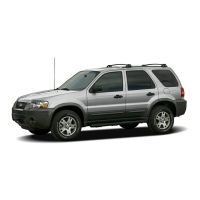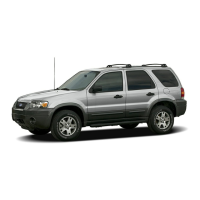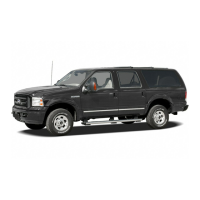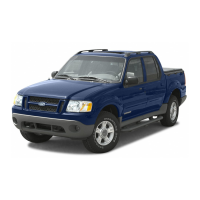
Do you have a question about the Ford 2005 GT40 and is the answer not in the manual?
| Brand | Ford |
|---|---|
| Model | 2005 GT40 |
| Category | Automobile |
| Language | English |
Warning about chemicals in engine exhaust and vehicle components known to cause cancer and birth defects.
Guidance on how to reduce risks and protect the environment, including warning symbols.
Safety instructions for electronic controls, SRS, and child seats.
Explanation of warning lights and gauges that alert to vehicle conditions.
Indicator for ABS faults and system servicing.
Overview of vehicle gauges including temperature, tachometer, and oil pressure.
Description of the 'Service engine soon' indicator light and its meaning.
Illumination indicating engine coolant temp, oil pressure, fuel level, or charging system issues.
Confirmation of the brake system warning light functionality and implications.
Indicator for SRS system functionality and associated chime.
Overview of the AM/FM CD system controls and features.
Overview of the manual air conditioning system controls.
Operation of parking lamps and headlamps.
Overview of the multi-function lever for wipers and washers.
Operation of power windows and safety precautions.
Safety advice on using mobile communication equipment while driving.
Procedure to deactivate or reactivate the autolock feature.
Procedure for locking both doors and anti-theft system activation.
Steps to reprogram remote entry transmitters.
Procedure for unlocking driver's door and all doors using remote entry.
Description of the engine immobilization system.
Instructions for programming spare keys to the vehicle.
Procedure for arming the perimeter alarm system.
Procedure for disarming the perimeter alarm system.
Description and usage of combination lap and shoulder belts.
Procedure to disengage automatic locking mode and activate vehicle sensitive mode.
Description of safety belt pretensioners and replacement after deployment.
Description of the BeltMinder feature for supplemental safety belt warning.
Procedure for deactivating/activating driver and passenger BeltMinder features.
Periodic inspection and maintenance of safety belt systems.
Overview of the supplemental restraint system and its function.
Safety advice regarding children and air bags, including seat placement.
Explanation of how the SRS system activates and its components.
How to check SRS system operational status via readiness light or tone.
Description of the passenger front air bag ON/OFF switch.
Procedure for turning the front passenger air bags back on.
Criteria for deactivating the passenger front air bag based on NHTSA guidelines.
NHTSA deactivation criteria regarding passenger medical conditions.
Guidelines for using safety belts for children who have outgrown child seats.
Explains why shoulder belts are crucial when using booster seats.
Steps for installing a child safety seat, including buckle and belt usage.
Procedure for installing child seats using combination lap and shoulder belts.
Continued procedure for installing child seats with belts.
Procedure for attaching child safety seats using tether straps.
Details on LATCH system usage for child seat anchors.
Safety notes regarding seatback reclining and cargo placement.
Precautions for maximizing restraint effectiveness and child safety.
Description of the safety belt warning light and chime.
Key precautions for using the SRS system safely.
Procedure for turning the passenger front air bag off.
Information on when children outgrow toddler seats and need booster seats.
General guidelines for using child and infant safety seats.
NHTSA recommendation for minimum distance from driver air bag.
General information on using safety restraints for children.
Key precautions for using child safety seats and restraints.
Importance of proper tire inflation and inspection procedures.
Instructions and recommendations for inflating tires correctly.
Step-by-step guide for checking and adjusting tire pressure.
Requirements and recommendations for replacing tires and wheels.
Information about the vehicle's emergency tire inflation kit.
Tips for safe operation and usage of the tire inflation kit.
Two-stage procedure for repairing a tire puncture with the inflation kit.
Continued steps for reinflating the tire with sealing compound and air.
Second stage of puncture repair: checking and adjusting tire pressure.
Continued steps for checking and adjusting tire pressure.
Torque specifications for wheel lug nuts.
Advice on maintaining Ford GT tires for optimal performance.
Steps to calculate available cargo and luggage load capacity.
Safe procedure for changing a flat tire while driving.
First stage of puncture repair: reinflating with sealing compound and air.
Guide to proper vehicle loading and weight ratings.
Procedure for determining the correct load limit for the vehicle.
Importance of tire and wheel alignment for vehicle handling.
Overview of starting the vehicle and ignition positions.
Precautions for starting and operating the vehicle in cold weather.
Procedure for starting the engine using the key and start button.
Procedure for setting and releasing the parking brake.
Overview of manual transmission operation.
Recommendations for optimal shift speeds for fuel economy.
Continued advice for driving through water and drying brakes.
Safety precautions regarding harmful exhaust fumes.
Description of the ABS system and its characteristics.
Explanation of clutch operation and starter interlock.
Description of the ABS warning lamp and its meaning.
Procedure for parking the vehicle safely.
Instructions for using the ABS system during hard braking.
Advice and precautions for driving through water.
Overview of Ford's complimentary roadside assistance program.
Procedure for resetting the fuel pump shut-off switch.
Chart detailing standard fuse amperage ratings and their corresponding colors.
Safety precautions and preparation for jump starting a vehicle.
Procedure for connecting jumper cables to batteries.
Continued procedure for connecting jumper cables, including grounding.
Procedure for removing jumper cables in reverse order.
Continued procedure for removing jumper cables.
Recommendations and warnings regarding wrecker towing procedures.
Steps to prepare the vehicle for jump starting.
Steps for starting the engine of the disabled vehicle.
Information on obtaining warranty repairs and service.
Procedure for reporting safety defects to NHTSA and Ford.
Instructions for washing the vehicle's exterior safely and effectively.
Recommendations for servicing the vehicle, including DIY items and professional service.
Procedure for opening the vehicle's engine compartment.
Procedure for closing the engine compartment cover securely.
Identification of key components in the engine compartment.
Identification of remaining components in the engine compartment.
Steps for checking engine oil level using the dipstick.
Procedure for adding engine oil and ensuring correct level.
Important safety precautions when handling automotive fuels.
Guidelines for handling automotive fuel safely.
Methods for calculating fuel economy.
Continued driving habits for better fuel economy.
Procedure for checking and adding power steering fluid.
Safety warnings regarding fuel tank overfilling and fuel handling.
General safety precautions to follow when servicing the vehicle.
Recommendations for engine oil type, viscosity, and filter.
Procedure for adding engine coolant and safety precautions.
Tips and habits for improving fuel economy.
Procedure for checking the engine oil level.
Procedure for checking engine coolant level and concentration.
Steps for adding engine coolant safely, including pressure release.
Procedure for checking engine coolant level when the engine is cold.
List of maintenance checks and inspections to be performed by the owner.












